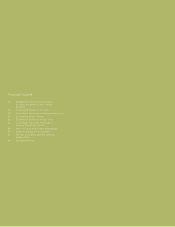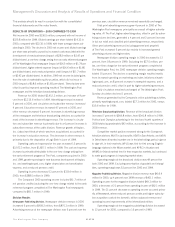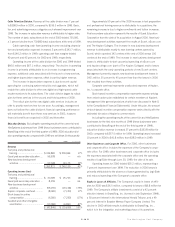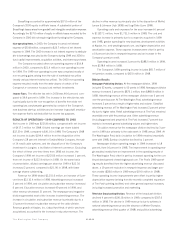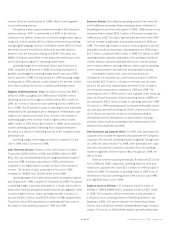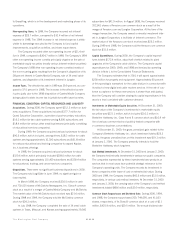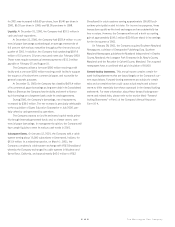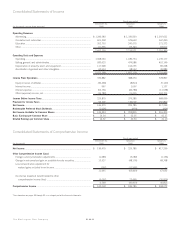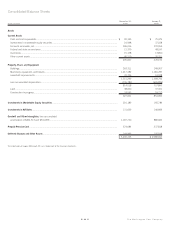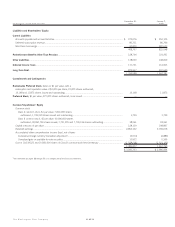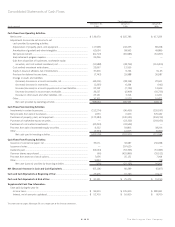Washington Post 2000 Annual Report Download - page 5
Download and view the complete annual report
Please find page 5 of the 2000 Washington Post annual report below. You can navigate through the pages in the report by either clicking on the pages listed below, or by using the keyword search tool below to find specific information within the annual report.
revenue (third and fourth quarter of 1998), offset in part by growth
in local advertising revenue.
Competitive market position remained strong for the Company’s
television stations. WJXT in Jacksonville and KSAT in San Antonio
continued to be ranked number one in the latest ratings period, sign-on
to sign-off, in their markets; WPLG in Miami achieved the top ranking
among English-language stations in the Miami market; WDIV in Detroit
was ranked second in the Detroit market with very little distance
between it and the first place ranking; and KPRC in Houston and
WKMG in Orlando ranked third in their respective markets but contin-
ued to make good progress in improving market share.
Operating margin at the broadcast division was 49 percent in
1999, compared to 48 percent in 1998. Excluding amortization of
goodwill and intangibles, operating margin was 53 percent in 1999
and 52 percent in 1998. The improvement in 1999 operating margin
is attributable to 1999 expense control initiatives, the benefits of which
were offset in part by the decline in national advertising revenue.
Magazine Publishing Division. Magazine division revenue was $401.1
million for 1999, up slightly over 1998 revenue of $399.5 million.
Operating income for the magazine division totaled $62.1 million in
1999, an increase of 39 percent over operating income of $44.5 mil-
lion in 1998. The 39 percent increase in operating income is primarily
attributable to the operating results of Newsweek. At Newsweek, oper-
ating income improved as a result of an increase in the number of
advertising pages at the domestic edition, higher pension credits
($48.3 million in 1999 versus $35.9 million in 1998), and a reduction
in other operating expenses. Offsetting these improvements were
the effects of a decline in advertising revenue at the Company’s trade
periodicals unit.
Operating margin of the magazine division increased to 15 per-
cent in 1999, from 11 percent in 1998.
Cable Television Division. Revenue at the cable division increased
13 percent to $336.3 million in 1999, from $298.0 million in 1998.
Basic, tier, pay, and advertising revenue categories showed improve-
ment over 1998. Increased subscribers in 1999, primarily from
acquisitions, and higher rates accounted for most of the increase in
revenue. The number of basic subscribers at the end of 1999
increased to 739,850 from 733,000 at the end of 1998.
Operating margin at the cable division before amortization expense
was 29 percent for 1999, compared to 30 percent for 1998. The decline
in operating margin is primarily attributable to a 16 percent increase in
depreciation expense arising from system rebuilds and upgrades, offset
in part by higher revenue. Cable operating cash flow increased 11
percent to $140.2 million, from $126.5 million in 1998. Approximately
70 percent of the 1999 improvement in operating cash flow is due to
the results of cable systems acquired in 1999 and 1998.
Education Division. Excluding the operating results of the career fair
and HireSystems businesses (these businesses were contributed to
BrassRing at the end of the third quarter of 1999), 1999 revenue for the
education division totaled $240.1 million, a 40 percent increase from
1998 revenue of $171.4 million. Approximately two-thirds of the 1999
revenue increase is attributable to businesses acquired in 1999 and
1998. The remaining increase in revenue is due to growth in the test
preparation and Score! businesses. Operating losses for 1999 totaled
$15.7 million, compared to $6.0 million in 1998. The decline in 1999
operating results is primarily attributable to the opening of new Score!
centers, start-up costs associated with eScore.com, and the develop-
ment of various distance learning initiatives, offset in part by operating
income improvements in the traditional test preparation business.
Including the results of the career fair businesses and
HireSystems, the education and career services division’s 1999 rev-
enue totaled $257.5 million, a 32 percent increase over the same
period in the prior year. Approximately two-thirds of the increase is
due to business acquisitions completed in 1999 and 1998. The
remaining increase in 1999 revenue is due to growth in the test prepa-
ration and Score! businesses. Division operating losses of $38.0 mil-
lion represent a $30.5 million increase in operating losses over 1998.
The decline in 1999 operating results is primarily attributable to start-
up costs associated with opening new Score! centers and the launch
of the eScore.com web site, as well as increased spending for
HireSystems and the development of various distance learning
initiatives, offset in part by operating income improvements in the
traditional test preparation business.
Other Businesses and Corporate Office. For 1999, other businesses and
corporate office includes the expenses associated with the Company’s
corporate office and the operating results of Legi-Slate through June
30, 1999, the date of its sale. For 1998, other businesses and corpo-
rate office includes the Company’s corporate office, the operating
results of Legi-Slate, and the results of MLJ through July 1998, the
date of its sale.
Revenue for other businesses totaled $3.8 million and $11.5 mil-
lion in 1999 and 1998, respectively. Operating losses for other busi-
nesses and corporate office were $27.1 million for 1999 and $33.4
million for 1998. The decrease in operating losses in 1999 is due to
the absence of full-year operating losses of MLJ (sold in July 1998)
and Legi-Slate (sold in June 1999).
Equity in Losses of Affiliates. The Company’s equity in losses of
affiliates in 1999 was $8.8 million, compared to losses of $5.1 million
in 1998. The Company’s affiliate investments consist primarily of
a 54 percent non-controlling interest in BrassRing (formed in late
September 1999), a 50 percent interest in the International Herald
Tribune, and a 49 percent interest in Bowater Mersey Paper Company
Limited. The decline in 1999 affiliate results is primarily attributable
30 The Washington Post Company

